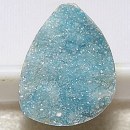|
|
||||||||||||||||
|
||||||||||||||||
|
||||||
|
|
|
|
Kinoite
|
|
| | |
| Discovered in 1969; IMA status: Valid (IMA approved 1970) | ||
|
| ||
|
Chemistry |
|
|
| |
|
Ca2Cu2Si3O8(OH)4 or Ca2Cu2Si3O10 • 2H2O | |
|
|
Calcium Copper Silicate Hydroxide or Hydrated Calcium Copper Silicate |
|
Molecular Weight: |
487.53 gm |
|
Composition: |
Calcium |
16.44 % |
Ca |
23.00 % |
CaO |
|
|
Copper |
26.07 % |
Cu |
32.63 % |
CuO |
|
|
Silicon |
17.28 % |
Si |
36.97 % |
SiO2 |
|
|
Hydrogen |
0.83 % |
H |
7.39 % |
H2O |
|
|
Oxygen |
39.38 % |
O |
|
|
|
|
|
100.00 % |
|
100.00 % |
= TOTAL OXIDE |
|
|
|
||||
|
Classification |
|
|
| |
|
Silicates (Germanates) | |
|
8/C.31-10 | |
|
|
9 : SILICATES (Germanates)
|
|
Related to: |
None |
|
Varieties: |
None |
|
Synonyms: |
IMA1969-037 |
|
|
|
|
Crystal Data |
|
|
|
|
|
As well-formed crystals, to 1.5 mm, tabular on [100], somewhat elongated along [001]; also in veinlets, massive. |
|
|
None |
|
|
|
|
|
Physical Properties |
|
|
|
|
|
Excellent on {010}; distinct on {100} and {001} |
|
|
n/a |
|
|
Brittle |
|
|
4.0 - 5.0 |
|
|
3.13 - 3.19 (g/cm3) |
|
|
Not Fluorescent |
|
|
Not Radioactive |
|
|
|
|
|
Optical Properties |
|
|
|
|
|
Light to deep azure-blue |
|
|
Transparent to Translucent |
|
|
Vitreous |
|
|
1.638 - 1.676 Biaxial ( - ) |
|
|
0.038 |
|
|
Distinct to relatively weak; r < v |
|
|
Strong; X = pale greenish blue; Y = blue; Z = deep blue |
|
|
|
|
|
Occurances |
|
|
|
|
|
Geological Setting: |
In vugs and veinlets in skarn (Santa Rita Mountains, Arizona, USA); in amygdules in basaltic lava flows (Calumet, Michigan, USA). |
|
Common Associations: |
Apophyllite, Copper (Santa Rita Mountains, Arizona, USA); Quartz, Calcite, Copper, Silver, Epidote, Pumpellyite, Chlorite (Calumet, Michigan, USA). |
|
Common Impurities: |
Mg |
|
Type Locality: |
Santa Rita Mountains, Pima County, Arizona, USA |
|
Year Discovered: |
1969; IMA approved 1970 |
|
View mineral photos: | |
|
|
|
|
More Information |
|
|
|
|
|
| |
|
|
|
|
Distribution:
In the USA, in Arizona, between Helvetia and Rosemont,
Santa Rita Mountains, Pima County, and in the Christmas
copper mine, Gila County; in the Bawana mine, about
six km northwest of Milford, Beaver County, Utah; and
in Michigan, in the Laurium and La Salle mines, Calumet,
Houghton County and at the Northwestern mine, Keweenaw
County. In Japan in the Fuka mine, Bitchu-cho (Bicchu-cho),
Takahashi City, Okayama Prefecture, Chugoku Region,
Honshu Island. |
|
|
We
have not photographed our Kinoite gems yet. Please
check back soon. |
